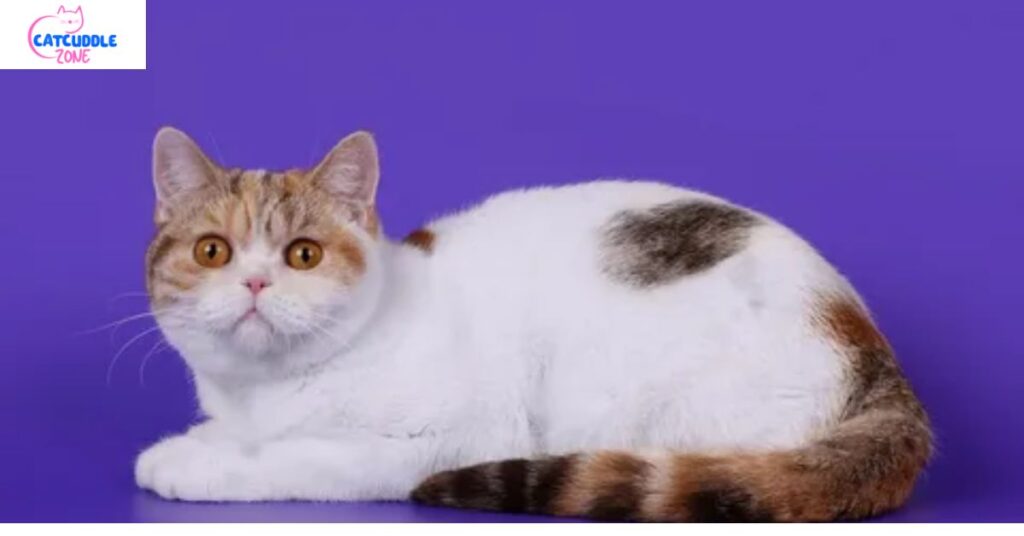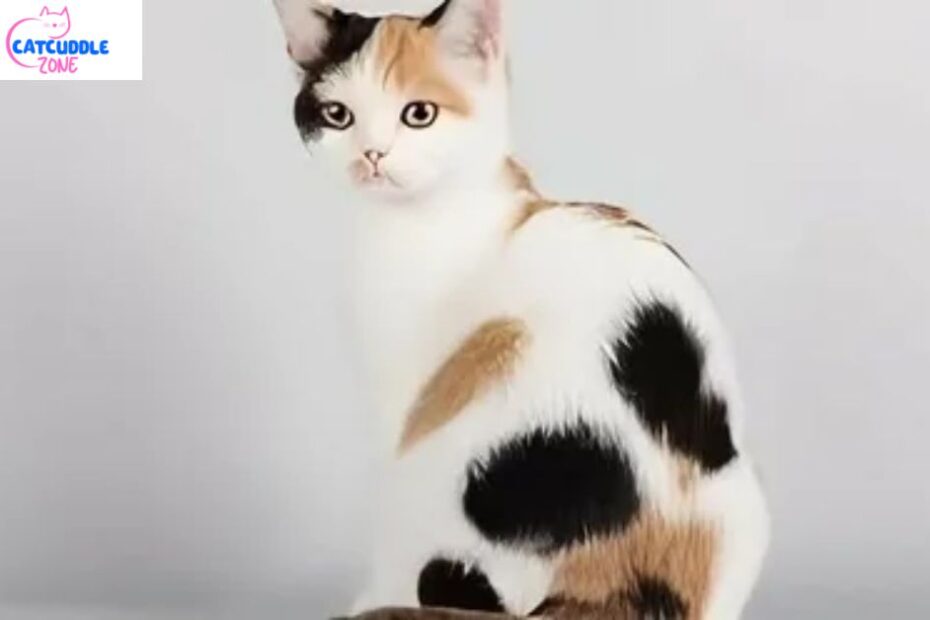The Harlequin cat is one of the most eye-catching felines in the world. With mostly white fur and large, bold patches of color, this unique cat pattern stands out in any crowd. These cats are not tied to a single breed but can be seen across many white coat cat breeds.
Their beautiful look comes from special feline coat genetics that produce large color blocks. This cat’s coat coloration makes them a favorite among pet lovers in the USA. Whether you’re a breeder or just a cat fan, the harlequin’s charm is hard to ignore.
History & Origins of the Harlequin Pattern
Historical cat records show that white and spotted cats have existed for centuries. While the harlequin term is newer in cat fancy terminology, similar markings have appeared in ancient artwork and literature. European aristocrats often kept white and colored cats, which were admired for their graceful looks. In Asia, these white and colored cats were seen as lucky, especially when they had balanced color spots.
Over time, breeders noticed the irregular coat patches and began selecting for them. These markings became popular due to their beauty and rarity. The term “harlequin” became more widely used in the 20th century as breeders began recognizing the pattern. The Governing Council of Cat Fancy and other global groups started defining the cat breed coat colors more clearly, leading to official classification of the harlequin pattern.
How the Harlequin Cat Gained Popularity Over Time
In recent years, harlequin coloration has gained attention due to social media. Cat lovers in the USA post images of their uniquely marked pets, helping this feline coat genetics stand out. Some harlequin cats have even gone viral. Their playful markings and gentle faces are naturally eye-catching. This visual appeal has helped them grow in popularity beyond breeders and into mainstream homes.
Before social media, their popularity grew in cat shows and breeding clubs. Many cat fancy organizations began to include them in pattern classes. Some breeds with large white areas in cat fur were especially favored. The rise of purebred breeding also helped. As more people became aware of these cats’ beauty, demand for them as both show cats and pets increased steadily across the country.
Are Harlequin Cats a Breed or Just a Pattern?
A harlequin cat is not a breed. It’s a cat coat coloration pattern. You can find this pattern in many breeds, including the oriental shorthair and snowshoe cat. It’s important not to confuse the coat with the breed itself. The harlequin pattern results from genes, not breed standards. A cat can have a harlequin look but belong to any of several breeds.
Breed standards set by cat fancy organizations describe how these patterns are judged. According to the cat breed standards, the harlequin must have a mostly white coat with well-defined color patches. There is no official “Harlequin Cat Breed.” However, many white dominant cat breeds may display this look naturally.
Breeds That Can Have a Harlequin Coat
Many breeds can show a harlequin cat pattern. The most common include the Turkish Van, Oriental Shorthair, Snowshoe, British Shorthair, and Japanese Bobtail. Each breed expresses the pattern differently, but the common trait is the contrast between the white coat and the colored patches on white cats. Some breeds are more likely to carry the gene responsible for cat coat coloration, especially the piebald gene in cats.
Other breeds like the American Shorthair and Domestic Shorthair may also carry the pattern. The chance of a harlequin appearance increases through selective cat breeding. Breeders track feline coat genetics to create litters with predictable patterns. However, there’s still variation in the way each kitten’s coat appears.
Harlequin Cat Coat Colors and Variations
The harlequin color in cats can appear in several combinations. Black and white is the most popular. But you’ll also see gray, orange, cream, and even tabby versions. Some cats have tabby markings in harlequin cats, where the color patches show stripes or spots. These cats combine multiple cat color variations in one coat.
Some harlequins may even show three colors—these are tri-colored cats. Others display patterns like calico or tortoiseshell within their patches. The variety of cat color standards makes each one special. Depending on the breed and gene mix, the patch layout and color intensity can vary widely.

Genetics Behind the Harlequin Pattern
The harlequin cat pattern is a result of the piebald gene in cats. This gene controls the spread of pigment cells across the skin. In harlequins, pigment is mostly blocked, allowing for a white base coat. The few areas where color shows up form the large, bold spots. These irregular coat patches create the classic harlequin look.
Cat pattern genetics can be complex. Two harlequin parents won’t always produce harlequin kittens. This depends on how dominant or recessive the genes are. The placement of patches is also random, which is why no two harlequin cats look the same. The inheritance pattern is studied by geneticists who track domestic cat coloration traits across generations.
Coat Patterns Similar to Harlequin Cats
While harlequin is a unique look, it shares features with other cat coat pattern types. The van pattern cats have color only on their head and tail, while the body is fully white. Tuxedo cats, on the other hand, have black with a white chest and paws. Piebald cats have uneven white spotting but not as much white as harlequins.
Here’s a quick comparison:
| Pattern Type | White Coverage | Main Difference |
| Harlequin | 60–80% | Large, uneven colored patches |
| Van | 80–95% | Color mostly on head and tail |
| Tuxedo | 30–50% | Color is dominant with white accents |
| Piebald | Varies | Irregular white and color mix |
These patterns are all influenced by feline coat genetics and vary depending on breed, ancestry, and selective breeding.
Unique and Fun Facts About Harlequin Cats
Every harlequin cat is one of a kind. Their markings don’t follow a set pattern, making them incredibly special. Some cat owners say their harlequin looks like it has a heart on its fur or a tiny mask. These unique cat markings make them popular on social media and in art. Some breeders even name kittens based on the shape of their spots.
Some harlequins are featured in ads, cartoons, or books. Their look is that striking. You might even spot one in a rescue shelter labeled as a “rare” find. Still, the pattern is more common than people think. It just appears in unexpected combinations, often as a surprise in mixed-breed litters.
Are Harlequin Cats Good Pets? Temperament & Care Guide
The temperament of harlequin cats is based on the breed of cats. An example is a snowshoe cat may be active compared to a British shorthair, which is calm. Generally speaking, the harlequin-marked cats are affectionate, sociable, and playful. They get along well with families, provided it is brought up indoors from an early age.
Care-wise, they are easy to tend to, assuming that they are not long-haired. The majority of the short-haired harlequin cats require simple brushing once a week. They perform very well on a high-protein diet and require playing to remain happy. Just as with any cat, they should be taken to the vet regularly to prevent issues that are typical to cats, such as obesity or mouth problems.
Conclusion: Is a Harlequin Cat Right for You?
A harlequin cat is a beautiful choice for those who want a truly special companion. With their dramatic cat coat coloration and loving nature, they can brighten any home. Their random harlequin coloration makes them feel like living artwork. But remember, personality comes from breed and environment—not just appearance.
Before you get one, consider your lifestyle. Do you have time to play and groom them? Are you open to cat adoption advice? Many shelters have harlequins waiting for loving homes. Whether you adopt or go through selective cat breeding, these spotted beauties make unforgettable pets.
(FAQs)
What is a harlequin cat?
A harlequin cat has a mostly white coat with several large, unevenly colored patches, often due to the piebald gene in cats.
What is the difference between a calico and a harlequin cat?
A calico has three colors in a random mix, while a harlequin has a white base with bold colored patches and often fewer colors.
What cat costs $100,000?
The Ashera cat, a rare hybrid breed, is known to cost up to $100,000 due to its exotic look and limited availability.
Are harlequin cats friendly?
Yes, harlequin cats are typically friendly and social, but their temperament depends on their breed and how they’re raised.
What is the rarest pet cat breed?
The Lykoi cat, also called the “werewolf cat,” is one of the rarest pet cat breeds in the world due to its unique appearance and limited breeding.
